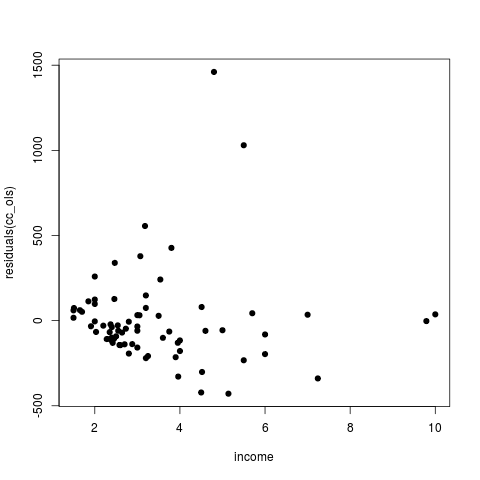Supported by Dr. Osamu Ogasawara and  providing providing  . . |
|
Last data update: 2014.03.03 |
Expenditure and Default DataDescriptionCross-section data on the credit history for a sample of applicants for a type of credit card. Usagedata("CreditCard")
FormatA data frame containing 1,319 observations on 12 variables.
DetailsAccording to Greene (2003, p. 952) Greene (2003) provides this data set twice in Table F21.4 and F9.1, respectively.
Table F9.1 has just the observations, rounded to two digits. Here, we give the
F21.4 version, see the examples for the F9.1 version. Note that SourceOnline complements to Greene (2003). Table F21.4. http://pages.stern.nyu.edu/~wgreene/Text/tables/tablelist5.htm ReferencesGreene, W.H. (2003). Econometric Analysis, 5th edition. Upper Saddle River, NJ: Prentice Hall. See Also
Examples
data("CreditCard")
## Greene (2003)
## extract data set F9.1
ccard <- CreditCard[1:100,]
ccard$income <- round(ccard$income, digits = 2)
ccard$expenditure <- round(ccard$expenditure, digits = 2)
ccard$age <- round(ccard$age + .01)
## suspicious:
CreditCard$age[CreditCard$age < 1]
## the first of these is also in TableF9.1 with 36 instead of 0.5:
ccard$age[79] <- 36
## Example 11.1
ccard <- ccard[order(ccard$income),]
ccard0 <- subset(ccard, expenditure > 0)
cc_ols <- lm(expenditure ~ age + owner + income + I(income^2), data = ccard0)
## Figure 11.1
plot(residuals(cc_ols) ~ income, data = ccard0, pch = 19)
## Table 11.1
mean(ccard$age)
prop.table(table(ccard$owner))
mean(ccard$income)
summary(cc_ols)
sqrt(diag(vcovHC(cc_ols, type = "HC0")))
sqrt(diag(vcovHC(cc_ols, type = "HC2")))
sqrt(diag(vcovHC(cc_ols, type = "HC1")))
bptest(cc_ols, ~ (age + income + I(income^2) + owner)^2 + I(age^2) + I(income^4), data = ccard0)
gqtest(cc_ols)
bptest(cc_ols, ~ income + I(income^2), data = ccard0, studentize = FALSE)
bptest(cc_ols, ~ income + I(income^2), data = ccard0)
## More examples can be found in:
## help("Greene2003")
Results
R version 3.3.1 (2016-06-21) -- "Bug in Your Hair"
Copyright (C) 2016 The R Foundation for Statistical Computing
Platform: x86_64-pc-linux-gnu (64-bit)
R is free software and comes with ABSOLUTELY NO WARRANTY.
You are welcome to redistribute it under certain conditions.
Type 'license()' or 'licence()' for distribution details.
R is a collaborative project with many contributors.
Type 'contributors()' for more information and
'citation()' on how to cite R or R packages in publications.
Type 'demo()' for some demos, 'help()' for on-line help, or
'help.start()' for an HTML browser interface to help.
Type 'q()' to quit R.
> library(AER)
Loading required package: car
Loading required package: lmtest
Loading required package: zoo
Attaching package: 'zoo'
The following objects are masked from 'package:base':
as.Date, as.Date.numeric
Loading required package: sandwich
Loading required package: survival
> png(filename="/home/ddbj/snapshot/RGM3/R_CC/result/AER/CreditCard.Rd_%03d_medium.png", width=480, height=480)
> ### Name: CreditCard
> ### Title: Expenditure and Default Data
> ### Aliases: CreditCard
> ### Keywords: datasets
>
> ### ** Examples
>
> data("CreditCard")
>
> ## Greene (2003)
> ## extract data set F9.1
> ccard <- CreditCard[1:100,]
> ccard$income <- round(ccard$income, digits = 2)
> ccard$expenditure <- round(ccard$expenditure, digits = 2)
> ccard$age <- round(ccard$age + .01)
> ## suspicious:
> CreditCard$age[CreditCard$age < 1]
[1] 0.5000000 0.1666667 0.5833333 0.7500000 0.5833333 0.5000000 0.7500000
> ## the first of these is also in TableF9.1 with 36 instead of 0.5:
> ccard$age[79] <- 36
>
> ## Example 11.1
> ccard <- ccard[order(ccard$income),]
> ccard0 <- subset(ccard, expenditure > 0)
> cc_ols <- lm(expenditure ~ age + owner + income + I(income^2), data = ccard0)
>
> ## Figure 11.1
> plot(residuals(cc_ols) ~ income, data = ccard0, pch = 19)
>
> ## Table 11.1
> mean(ccard$age)
[1] 32.08
> prop.table(table(ccard$owner))
no yes
0.64 0.36
> mean(ccard$income)
[1] 3.3693
>
> summary(cc_ols)
Call:
lm(formula = expenditure ~ age + owner + income + I(income^2),
data = ccard0)
Residuals:
Min 1Q Median 3Q Max
-429.00 -130.39 -51.89 53.96 1460.61
Coefficients:
Estimate Std. Error t value Pr(>|t|)
(Intercept) -237.031 199.316 -1.189 0.23855
age -3.091 5.515 -0.560 0.57710
owneryes 27.970 82.918 0.337 0.73693
income 234.412 80.370 2.917 0.00481 **
I(income^2) -15.002 7.469 -2.008 0.04863 *
---
Signif. codes: 0 '***' 0.001 '**' 0.01 '*' 0.05 '.' 0.1 ' ' 1
Residual standard error: 284.7 on 67 degrees of freedom
Multiple R-squared: 0.2436, Adjusted R-squared: 0.1985
F-statistic: 5.395 on 4 and 67 DF, p-value: 0.0007938
> sqrt(diag(vcovHC(cc_ols, type = "HC0")))
(Intercept) age owneryes income I(income^2)
212.903038 3.300465 92.176017 88.864892 6.944454
> sqrt(diag(vcovHC(cc_ols, type = "HC2")))
(Intercept) age owneryes income I(income^2)
220.996881 3.446417 95.659360 92.082043 7.199455
> sqrt(diag(vcovHC(cc_ols, type = "HC1")))
(Intercept) age owneryes income I(income^2)
220.704255 3.421401 95.553541 92.121089 7.198913
>
> bptest(cc_ols, ~ (age + income + I(income^2) + owner)^2 + I(age^2) + I(income^4), data = ccard0)
studentized Breusch-Pagan test
data: cc_ols
BP = 14.327, df = 12, p-value = 0.2803
> gqtest(cc_ols)
Goldfeld-Quandt test
data: cc_ols
GQ = 15.006, df1 = 31, df2 = 31, p-value = 1.372e-11
> bptest(cc_ols, ~ income + I(income^2), data = ccard0, studentize = FALSE)
Breusch-Pagan test
data: cc_ols
BP = 41.921, df = 2, p-value = 7.889e-10
> bptest(cc_ols, ~ income + I(income^2), data = ccard0)
studentized Breusch-Pagan test
data: cc_ols
BP = 6.1863, df = 2, p-value = 0.04536
>
> ## More examples can be found in:
> ## help("Greene2003")
>
>
>
>
>
> dev.off()
null device
1
>
|
